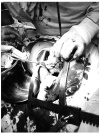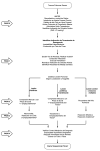Damage control surgery in lung trauma
- PMID: 34188322
- PMCID: PMC8216053
- DOI: 10.25100/cm.v52i2.4683
Damage control surgery in lung trauma
Abstract
Damage control techniques applied to the management of thoracic injuries have evolved over the last 15 years. Despite the limited number of publications, information is sufficient to scatter some fears and establish management principles. The severity of the anatomical injury justifies the procedure of damage control in only few selected cases. In most cases, the magnitude of the physiological derangement and the presence of other sources of bleeding within the thoracic cavity or in other body compartments constitutes the indication for the abbreviated procedure. The classification of lung injuries as peripheral, transfixing, and central or multiple, provides a guideline for the transient bleeding control and for the definitive management of the injury: pneumorraphy, wedge resection, tractotomy or anatomical resection, respectively. Identification of specific patterns such as the need for resuscitative thoracotomy, or aortic occlusion, the existence of massive hemothorax, a central lung injury, a tracheobronchial injury, a major vascular injury, multiple bleeding sites as well as the recognition of hypothermia, acidosis or coagulopathy, constitute the indication for a damage control thoracotomy. In these cases, the surgeon executes an abbreviated procedure with packing of the bleeding surfaces, primary management with packing of some selected peripheral or transfixing lung injuries, and the postponement of lung resection, clamping of the pulmonary hilum in the most selective way possible. The abbreviation of the thoracotomy closure is achieved by suturing the skin over the wound packed, or by installing a vacuum system. The management of the patient in the intensive care unit will allow identification of those who require urgent reintervention and the correction of the physiological derangement in the remaining patients for their scheduled reintervention and definitive management.
Las técnicas de control de daños aplicadas al manejo de lesiones torácicas han evolucionado en los últimos 15 años. A pesar de que el número de publicaciones es limitado, la información es suficiente para desvirtuar algunos temores y establecer los principios de manejo. La severidad del compromiso anatómico justifica el procedimiento de control de daños solamente en algunos casos. En la mayoría, la magnitud del deterioro fisiológico y la presencia de otras fuentes de sangrado dentro del tórax o en otros compartimientos corporales constituyen la indicación del procedimiento abreviado. La clasificación de la lesión pulmonar como periférica, transfixiante y central o múltiple, proporciona una pauta para el control transitorio del sangrado y para el manejo definitivo de la lesión: neumorrafía, resección en cuña, tractotomía o resecciones anatómicas, respectivamente. La identificación de ciertos patrones como la necesidad de toracotomía de reanimación o de oclusión aórtica, la existencia de un hemotórax masivo, de una lesión pulmonar central, una lesión traqueobronquial o una lesión vascular mayor, así como el reconocimiento de hipotermia, acidosis o coagulopatía, constituyen la indicación de una toracotomía de control de daños. En estos casos, el cirujano concluye de manera abreviada los procedimientos con empaquetamiento de las superficies sangrantes, el manejo primario con empaquetamiento de algunas lesiones pulmonares periféricas o transfixiante seleccionadas y el aplazamiento de la resección pulmonar, pinzando el hilio de la manera más selectiva posible. La abreviación del cierre de la toracotomía se logra con la sutura de la piel sobre el empaquetamiento de la herida, o mediante la instalación de un sistema de presión negativa. El manejo del paciente en cuidados intensivos permitirá identificar aquellos que requieren reintervención urgente y corregir la alteración fisiológica de los restantes para su reoperación programada y manejo definitivo.
Keywords: Damage control surgery; balloon occlusion; cardiac output; chest tubes; heart arrest; hemostasis; hemostatics; hemothorax; lung injury; pneumonectomy; sternotomy; thoracotomy.
Copyright © 2021 Colombia Medica.
Conflict of interest statement
Conflict of Interest: The authors declare that they have no conflict of interest.
Figures














References
Publication types
MeSH terms
LinkOut - more resources
Full Text Sources
Medical

